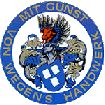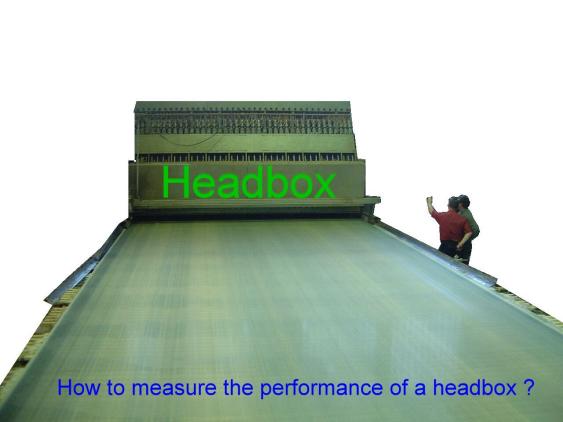 |
||||||||||
|
|
||||||||||
 |
 |
|||
|
How to measure the quality and performance of a papermachine headbox The main task of a papermachine ( PM ) headbox is to distribute fibers and fillers from the feeded suspension as uniform as possible on top of a running conveyor (wire) in view of time ( machine direction, MD ) and in view of localisation ( cross machine direction, CD ) . Even there is a very well performing PM headbox, the basis weight distribution of paper is influenced from other parts of the papermachine as well. Pressure variations from the constant part of PM could generate flow variations of the jet from the headbox finally. Although headboxes are able to reduce such pressure variations from the constant part very well, - and could be demonstrated with BTF-System - this pressure variations will result in variation of mass distribution on the running wire. It should be mentioned the different principles of headbox design of BTF and others. Conventional headboxes with CD flow spreaders will generate from variation of flow variation of mass distribution in CD and MD in the same time, which is a very unsufficient situation. But the wire itself and all the other dewatering devices will influence the initial mass distribution on the wire. Hopefully a more or less uniform mass distribution could be kept during a uniform filtration process and will not going worse. Non uniform abrasion or insufficient tension and stretching of the wire or wrong adjusted dewatering elements as foils and suction boxes may influence the mass distribution in cross machine direction. If there is enough data from measuring basis weight avaible, statistics could help to carry out the effect of mass distribution and its reasons. The most important tool to rectify the performance of a papermachine as a total system is analysis of variance of basis weight distribution in paper. To do this, there is the need of about 20 paper samples from the top of the produced paper reel as long as the trim of the papermachine is. Sometimes samples are simply called profiles and from this stripes of paper the basis weight should be measured on a small area. The two dimensional analysis of variance is able to separate the total variation into three parts. There are systematic variation in mashine direction and systematic variation in cross mashine direction and non systematic ( residual ) variation. As mentioned above and surching for reasons of such variation, MD variation could be supposed generated by the constant part or poor condition of the wire part. CD variation is mainly generated from the headbox or flow approach system. Generally headboxes with BTF design show significant less CD variation than others do. Sometimes the already described MD and CD variation are called systematic errors and they could be eliminated on principle or reduced in reality by elimination of the corresponding defects in the papermachine. If all systematic variation is eliminated, there are still the non systematic ( residual or stochastic ) variations. In the view of the author, this residual variation is a measurement to characterize the performance of a paper production unit. But this is only true if the systematic CD and MD variations are eliminated in fact. There are other statistical and number screening tools avaible to analyze systematic variations in CD and MD direction and to find the reasons. Some of this methods are looking on the (time) series of basis weigt figures and try to find out variations, which could be constructed by overlapping variations of special frequencies and amplitudes. For example it is possible to get from such an analyze a tracable variation of mass distribution ( significant amplitudes ) with a special frequency and the problem is nor far beyond to be solved. The most frequent and significant basis weight variation with frequency about 20 Hertz is caused nearly always from the rotor of the screens in front of the headbox. The rotating wings of the rotor are covering the main outlet of the screen periodically and this generate variations in pressure and flow to the headbox which could be found as periodic basis weight variations in the paper . That is the reason, why BTF-Systems are carefully designed in aspect of mechanical and hydraulic vibrations. The BTF distribution tank with a perforated plate and suitable design is one of the most performing unit to reduce hydraulic variation from the constant part and the special perforated plate converts the non desired vibrations to micro turbulences, just wright to provide floculation of the suspension. Within the BTF-System the forming unit takes care of the uniform distribution of the fiber containing suspension in cross machine direction. If the headbox generate systematic CD variation, this could be reduced on conventional headboxes by bending the slice or lip and on dilution headboxes with zone controlled consistency by dilution water , well known as profil control. The BTF - System is based on simple hydraulic basics and it works stable without any ( sophisticated ) control. Contrary to other systems the additional feeded dilution water for basis weight profil control does not effect the amount of flow to the zones of the headbox or forming unit. If there is an alteration of flow, due to profil control, into the feeding zones of the headbox, this would cause CD flow inside the headbox immediately. This ends up with the well known but non desired result in paper quality, very similar to results from headboxes with slice control. Very often the defects are non flat paper and bump effects on paper with faster speeds of PM. Faster speed needs a more stronger drying, and drying amplifies this well known defect caused by different shrinking and shrinking rates, originally initiated by non uniform mass distribution and non uniform fiber orientation in the paper. On cutted sheets or copy paper you may see non flat paper , on printing papers there are wrinkles or prints out of register very often. From these findings there are two definite strategies to improve the quality of paper in view of basis weigt distribution. A headbox could cause CD variation and have to be designed in such a manner, that all systematic CD variation could be avoides or elimineted. The patented BTF-System meet all requirements of construction and is designed to control basis weigt profil manually or automatically with principals of dilution for further improvements. With BTF-Systems you could get garantees for CD, MD and residual variation based on new euipment as well as on headbox rebuilds, which are always more ambitious than usual. The second strategy should figure out all periodic variations by time series analysis and to eliminate those variations which are caused by poor design very often. The constant part, all pumps, cleaners, screens and deculator should be investigated for critical pressure and flow variations. With similar aspects the forming section and wire part of a PM should be screened. The task to improve quality of paper takes some effort and have to be done in steps frequently, but the described methods and machines consider remarkable improvements. The residual variation from analysis of variance of basis weight is the smallest and remaining variation of basis weight in paper. This becomes true and reality in case of elimination of all systematic sources of (trouble) disturbances. This remaining variation figures out the quality of paper and the performance of a papermashine to form a uniform sheet as well. In the future, the author will discuss methods to reduce stochastic variations in paper with technology based tools as well, for instance by usage of specific chemicals.
Literature : Göttsching/Gräber: Über den Einfluß der Papiermaschinenarbeit auf die Schwankungen der flächenbezogenen Masse und anderer Papiereigenschaften. Totally 5 parts, written in German language and with English and French summary, published in Papier 31, Nr.9 (1977) ; Papier 32, Nr.1 (1978) ; Papier 32, Nr. 10 (1978) ; Papier 33, Nr.2 (1979) ; Papier 33, Nr. 5 (1979). Gräber: Ausgewählte Meßmethoden zur meßtechnischen Beurteilung von Blattbildungssystemen, Wbl. F. Papierfabrikation 106, 133-138 (1978), Nr.4 |
| [Papermachine] |